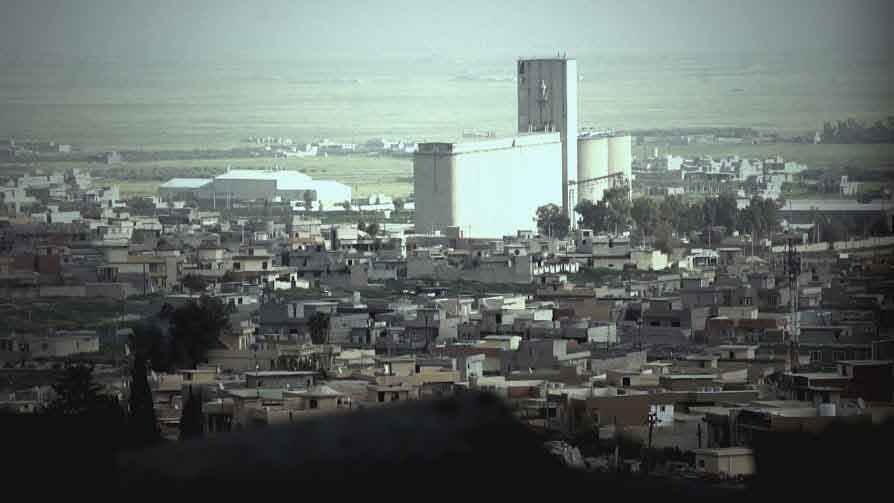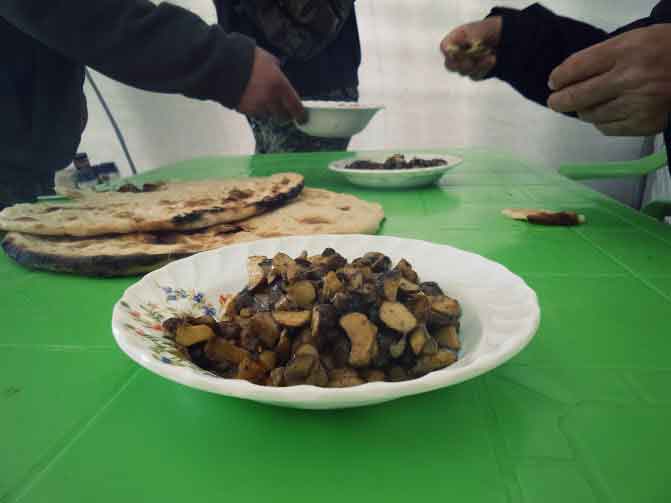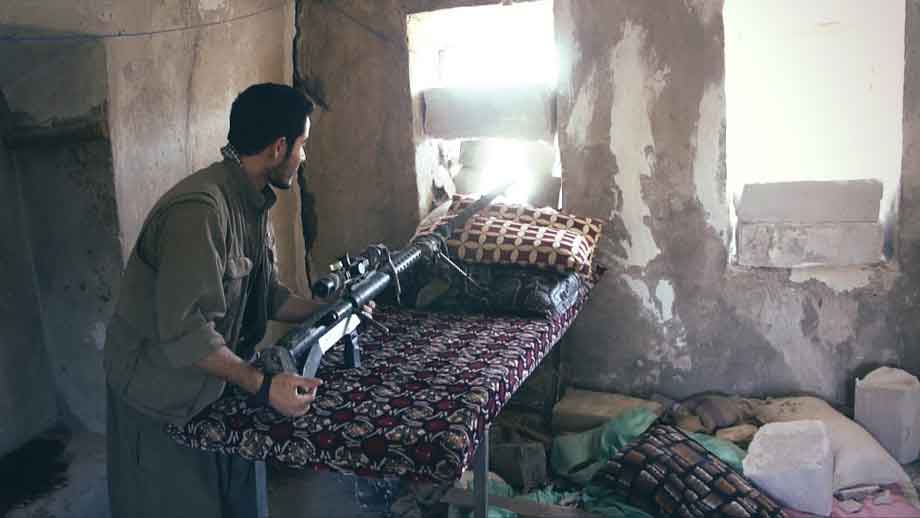Shangal, The Land Of Legends In Chains
By Zanyar Omrani
09 May, 2015
Countercurrents.org

Shangal city from over the mountains
Today I came across a sort of wild plant in a local bazaar in Dirik, a plant frequently seen in every corner of Shangal. Before heading toward Rojava (Syrian Kurdistan), I spent some days in the heart of Mesopotamia among endless legends. Here is Shangal, a city which has seen many previous assaults by jihadists, according to its people.
Legends permeate every aspect of Yezidi people’s lives, be it in the town or in the front lines fighting ISIS. They have a legend for every event, but what drew my attention was a plant called ‘komi’, which is holy for Yezidis.
There was heavy rain on my first night in Shangal Mountains, accompanied by the storm before long. There were Guevara, Berxodan, and I huddling in a white 3-person tent which was part of the training camp of the newly established Shangal Protection Units (YBŞ). Guevara joked with Berxodan, “Please telephone God and tell Him we’re trapped by heavy train in Shangal Mountains, and we cannot stand more disasters to come.” Berxodan did not seem to be very upset about the rain, “I hope it goes on raining, so we can have komi tomorrow.” Besides Shangal Mountains, komi can be found in some limited parts of Rojava (Syrian Kurdistan), where it is called ‘dimblan’.

Cooked komi
I got to know that the season for komi is approaching its end when I saw this delicious food again in the bazaar of Dirik, so I decided to document my observations in Shangal before the end of komi. This plant looks like potatoes in color but it is smaller in size, and it gets as soft as mushrooms after it is cooked. Depending on the weather, it usually starts to sprout in late February, and it can be collected for a period of one month. Komi is usually boiled, toasted, or mixed with oil from farm animals and served with fried tomatoes. Tirizh, a Yezidi teenaged from Shangal, believed that Komi was “healing food”, and it strengthened eyesight. This wild plant is a great source of nutrition for the Yezidis and, in case of rainy seasons, it will lay claim to the bazaars of the Kurdish Region cities and towns, too.
On a rainy morning, Kamal Jundi and I headed toward Shangal Mountains to find some komi. This time, an AK 47 had replaced 25 friends who used to accompany him on such day trips. Kamal used a sharp knife-like device to uproot the Komi without hurting it. He believed that success in finding Komi depended on the person’s “risq”, their quota designated for them by divine providence”, rather than skill or good eyesight. It seemed that Kamal’s risq was a big share, as he collected 2 klios of komi. He said, “There is more komi in mountainous areas with little fertility compared to the fertile areas with lots of trees and plants, where it is more difficult to spot.” Komi, if large in size, can be sold for 12 thousand Iraqi dinars for each kilo, and the small ones 6 to 8 thousand for each kilo.
Yezidis love komi, and even the last year atrocities have not made them give up on this plant. Dersim Rojhelat, a member of the PKK training team, joking on their love for komi, said, “We have to try for one week to have them attend a short session, but if the rain lingers on for some time, you can’t find a soul in the mountain skirts.” Dersim added that some people got injured while collecting komi this year because ISIS had mined some parts of the mountains.
It’s not clear why this plant has been named “komi”, although there are some stories about this in the local oral tradition. Faqir is the second level of importance in the Yezidi religion hierarchy, and Faqir Jardo told me about a legend regarding the origin of komi. “According to a Yezidi myth, Mir Ibrahim Adma, a high-ranking cleric, would say the Qawls (Yezidi prayers) every early morning while facing the sunrise. One day a gazelle passed by when he was saying prayers. Mir Ibrahim was going to hunt the gazelle, but suddenly the gazelle spoke to him and asked him to let her go to the valley, where her babies were waiting to be fed, promising she would be back soon. The gazelle asked for 3 hours, one to get to her babies, one to feed them, and one to come back to Mir Ibrahim.
Mir Ibrahim agreed. The gazelle starts running toward the valley with breasts full of milk, which is leaking on the ground. She tells the story to her babies and they refuse to drink from the milk, insisting that the mom should not keep Mir Ibrahim waiting. The mom dashed to where Mir Ibrahim was waiting, who was surprised at the gazelle’s hurried return. Realizing the reason for the gazelle’s return without feeding the babies, Mir Ibrahim changed his mind about hunting the gazelle, telling the gazelle he would not hunt her, since the babies had understood and appreciated the true nature of his character. Thus, due to the milk drops from the gazelle on Shangal’s land, and God’s making a miracle out of it, there came into being a plant bestowed to Yezidis, which did not need seeds to grow.”
Now it was time for me to try this mysterious food. One by one they entered the tent used at eating times. The last one to join the komi lovers was a tall guy from the Shangal Protection Units. He said he joined in with people collecting and eating komi every year. He laid his gun and when he had the first parcel in his hand, I asked him what he thought of komi, the answer to which was short and quick, precluding any details, “Delicious.” I asked for details and he abruptly said, “Why are you stuck in komi and not talking about the catastrophe that happened to the people of Shangal?”
Before the Farman or after the Farman?
Whatever they may be talking about, a question follows, “Before the Farman or after the Farman?” Two mainly Kurdish populated towns, Shangal and Zumar, fell into the hands of ISIS in their quick advances in Iraq. 6000 Yezidis were killed by ISIS and 12000 more are missing, and the rest fled to safer cities. “Farman” is the word Yezidis use to refer to a genocide committed against them, and their history talks of more than 70 Farmans. Thousands of them were saved by YPG and YPJ forces, Kurdish military forces who have been fighting ISIS in Syria. After the Shangal massacre, YPG (People’s Protection Units) the military wing of the Democratic Union of Syrian Kurdistan, together with PKK guerrillas and the Peshmerga opened a new front against ISIS to liberate Shangal.
Some Yezidis fled to the Shangal Mountains to escape from the ISIS attacks. Many died on the mountains due to hunger, thirst, and lack of hygienic and medical facilities. Khodida, a Yezidi from Shangal, told me that, “The majority of the Arab tribes of the region consider us to be ‘najis’ (dirty), and they joined ISIS against us the moment ISIS took in.” Khodida said that ISIS forces had destroyed the important buildings of every town and city they had set foot in, and mined the important roads and especially the bridges.

PKK's Guerrilla in Frontline
I talked to many Yezidis during my stay in Shangal , and what they all agreed on as to the ISIS attacks was they all believed that Islamists attacking Yezidis is not something new. I asked Barakat for more explanation, “All of the four Rashudin Caliphs have attacked the Yezidi land and the traces of these attacks can be seen in our legends.” It is also recorded in Yezidis’ legends that “Gilgamesh and Sassanid kings have committed farmans, too.” According to the people of Shangal, they have once had a population of 84 millions, which has declined due to 74 farmans during the course of history. Most of the people of Shangal, both those I met in Erbil and those whose stories I listened to in Shangal, had a one common complaint. They said that the Peshmerga did not feel impelled to defend the Yezidis, but the timely interference of the YPG and the PKK to open a human corridor to save a great number of them had enormously increased the popularity of these two parties among Yezidis.
There is no end to stories and legends here. Rasho, a member of the Shangal Protection Units, who, like his fellow-believers, has a strong faith in legends, especially those told in the Mushaf Rash (the Black Book), a holy book for Yezidis, says, “It is predicted in Yezidis’ book that one day a group of people similar to the early Islam muslims will attack the Yezidis and some people from the mountains will rush to Yezidis’ rescue. Now we can believe that the people from the mountain, which have been referred to in our ancient scriptures, are the PKK guerrillas who came from the Qandil Mountains.
Interestingly, most Yezidis have problem pronouncing ‘PKK’, and they say it like ‘PPK’. The ISIS attacks facilitated the military presence of different Kurdish parties in the region. While looking for komi in Shangla mountains, we had time to have a bird’s-eye view over the green mountain skirts and the meadows. Each party’s flag shows the area they control; we can say the PDK (Kurdistan Democratic Party) and PUK (Patriotic Union of Kurdistan) Peshmerga control areas from Duhok to Shangal, and PKK guerrillas are in the mountainous areas of Shangal.
Contrary to claims made by PDK and PUK media, the majority of Shangal is still controlled by ISIS, and only the older part of the town, which makes 20 percent of it, is controlled by Kurdish forces. When I talked to Yezidis about the presence of different Kurdish forces, you could notice some distrust toward the Kurdish parties. They said, “We have fallen victim to their conspiracies.” The town seems calm from afar. Kamal, a young man from Shangal, is viewing the town with eyes full of regret, saying “There is no risk greater than returning to your hometown.”
Zanyar Omrani is a filmmaker and Kurdish human rights activist.
Translated by Farhad Khoshyar
Tags
.
Comments are moderated

